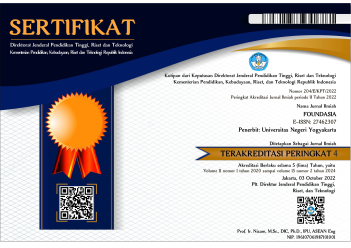Penerapan Metode Multisensori Berbantu Balok Hurup Dalam Meningkatkan Kemampuan Membaca Siswa Disleksia Di Sekolah Dasar Inklusi
Abstract
The ability to read is very important in life, because by reading we can find various information through various writings that are given to us by other people. By reading we can improve our knowledge skills with reading literacy in various ways. Obstacles in reading greatly affect students' cognitive abilities. Where should be reading, students are able to reason about various things in learning. However, if there are problems with just reading, it is very possible that this interferes with other things related to the learning process. There are several things that can cause students to experience reading difficulties. There are reading difficulties caused by students who suffer from dyslexia. Dyslexia in general is a learning disorder in children characterized by difficulty reading and writing. The main causative factor is the brain. But it could also be due to psychological, biological and educational factors seen from the way of learning. And to handle it, special treatment is needed for children who have dyslexia. In class 2, SDN Bantar Jati 9, Bogor City, there are students who have indications of dyslexia. The method in this research is qualitative with a case study approach. The results of the study show that the efforts made to improve the reading ability of dyslexic students are by applying the Multisensory Method. In the implementation of the application of the multisensory method requires learning media that can assist in the learning process, based on the results of research the appropriate media is to apply block letters media. The results showed that the application of the multisensory method assisted by letter blocks can improve the reading ability of dyslexic students. The conclusion is that the application of the multisensory method assisted by letter blocks is effective.
Full Text:
PDFReferences
Apriani, E., & Supardan, D. (2018). Language Learning Disabilities: How Can I Help My Students with Dyslexia? ENGLISH FRANCA : Academic Journal of English Language and Education, 2(2). https://doi.org/10.29240/ef.v2i2.598
Bailey, S. K., Aboud, K. S., Nguyen, T. Q., & Cutting, L. E. (2018). Applying a network framework to the neurobiology of reading and dyslexia. 1–9.
Caldani, S., Gerard, C. L., Peyre, H., & Bucci, M. P. (2020). Visual attentional training improves reading capabilities in children with dyslexia: An eye tracker study during a reading task. Brain Sciences, 10(8), 1–13. https://doi.org/10.3390/brainsci10080558
Cassidy, B. (2019). Cassidy urges full implementation of First Step Act dyslexia screening.
Chen, C., Schneps, M. H., Masyn, K. E., & Thomson, J. M. (2016). The Effects of Visual Attention Span and Phonological Decoding in Reading Comprehension in Dyslexia: A Path Analysis. Dyslexia, 22(4), 322–344. https://doi.org/10.1002/dys.1543
Colenbrander, D., Ricketts, J., & Breadmore, H. L. (2018). Early identification of dyslexia: Understanding the issues. Language, Speech, and Hearing Services in Schools, 49(4), 817–828. https://doi.org/10.1044/2018_LSHSS-DYSLC-18-0007
Creswell, J. W. (2018). EDUCATIONAL RESEARCH. Planning, Conducting and Evaluating Quantitative and Qualitative research.
Gosiewska-turek, B. M. (2022). Dyslexia , Self-efficacy , and Language Instruction in Foreign Language Learning — A Mixed Quantitative-qualitative Study. 8(1), 71–84.
Heim, S., Pape-Neumann, J., van Ermingen-Marbach, M., Brinkhaus, M., & Grande, M. (2015). Shared vs. specific brain activation changes in dyslexia after training of phonology, attention, or reading. Brain Structure and Function, 220(4), 2191–2207. https://doi.org/10.1007/s00429-014-0784-y
Jones, A. L., Holtgraves, T. G., & Sander, J. B. (2019). Attitudes and Knowledge of Future Teachers to Identify Struggling Readers. Teacher Educator, 54(1), 46–59. https://doi.org/10.1080/08878730.2018.1490842
Kelly, K, & Phillips, S. (2016). Teaching literacy to learners with dyslexia: A multi-sensory approach. Sage.
Mortimore, T. (2008). Dyslexia and Learning Style: A Practitioner’s Handbook: Second Edition. In Dyslexia and Learning Style: A Practitioner’s Handbook: Second Edition. https://doi.org/10.1002/9780470987940
Nuraeni, N., Winarsih, M., & Riana, B. (2018). Media Balok Kata (BTA) to Stimulate the Ability of Reading Word Recognition for Student with Learning Problem. 272, 231–234. https://doi.org/10.2991/indoeduc-18.2018.58
Pariaman, N., & Syofiani, W. (2012). Peningkatan Membaca Anak Melalui Permainan Dadu Kata Bergambar Di Taman Kanak-Kanak Aisyiyah Naras Pariaman. Jurnal Pesona, PAUD, I(1), 1–12.
Pratamawati, T., Solikhah, A., & Haryani, S. (2015). Perspektif Negatif Terhadap Anak Disleksia. Proseding Seminar Nasional PGSD UPY Dengan Tema Strategi Mengatasi Kesulitan Belajar Ketika Murid Anda Seorang Disleksia, 154–161.
Rappolt-Schlichtmann, G., Boucher, A. R., & Evans, M. (2018). From deficit remediation to capacity building: Learning to enable rather than disable students with dyslexia. Language, Speech, and Hearing Services in Schools, 49(4), 864–874. https://doi.org/10.1044/2018_LSHSS-DYSLC-18-0031
Rismanto, A. (2020). Kemampuan Membaca dan Menulis Siswa Disleksia Melalui Metode Simultaneous Multisensory Teaching Kemampuan Membaca dan Menulis Siswa Disleksia Melalui Metode Simultaneous Multisensory Teaching.
Rose, J. (2009). Identifying and Teaching Children and Young People with Dyslexia and Literacy Difficulties. In the Secretary of State for Children, Schools and Families (Issue June). DCSF Publications. https://doi.org/10.1016/B978-012370624-9/50018-9
Setiadi, H. W. (2015). Strategi Pembelajaran Untuk Meningkatkan Keterampilan Baca Tulis Siswa Disleksia. Seminar Nasional PGSD UPY Dengan Tema Strategi Mengatasi Kesulitan Belajar Ketika Murid Anda Seorang Disleksia STRATEGI, 88–96.
Shaywitz, B. A., & Shaywitz, S. E. (2020). The American experience: towards a 21st century definition of dyslexia. Oxford Review of Education, 46(4), 454–471. https://doi.org/10.1080/03054985.2020.1793545
Shaywitz, S. E., Fletcher, J. M., Holahan, J. M., Shneider, A. E., Marchione, K. E., Stuebing, K. K., Francis, D. J., Pugh, K. R., & Shaywitz, B. A. (1999). Persistence of dyslexia: The Connecticut Longitudinal Study at adolescence. Pediatrics, 104(6), 1351–1359. https://doi.org/10.1542/peds.104.6.1351
Siti Laras Andiyani, Ari Sofia, R. (2015). PENGGUNAAN MEDIA BALOK HURUF PADA KEMAMPUAN MENGENAL HURUF ANAK.
Supena, A., & Dewi, I. R. (2020). Metode Multisensori untuk Siswa Disleksia di Sekolah Dasar. Jurnal Basicedu, 5(1), 110–120. https://doi.org/10.31004/basicedu.v5i1.623
Tellis, W. (1997). Introduction to Case Study. The Qualitative Report, 3(2). http://www.nova.edu/ssss/QR/QR3-2/tellis1.html
Thambirajah, M. S. (2010). Developmental dyslexia: Clinical aspects. Advances in Psychiatric Treatment, 16(5), 380–387. https://doi.org/10.1192/apt.bp.108.006239
William L, H. (2013). Exceptional children: an introduction to special education. http://www.cec.sped.org
DOI: https://doi.org/10.21831/foundasia.v13i2.57974
Refbacks
- There are currently no refbacks.

This work is licensed under a Creative Commons Attribution-ShareAlike 4.0 International License.










